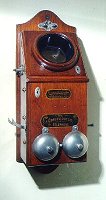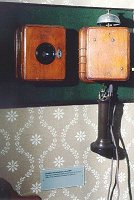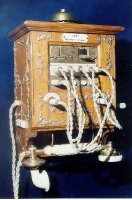 I can't find any information about the Consolidated Telephone Company, other than
the address printed on the exhibit, Telephone &
Electrical Works, Farringdon Road, London E.C. Notice the curious microphone shaped
like a shallow dish.
I can't find any information about the Consolidated Telephone Company, other than
the address printed on the exhibit, Telephone &
Electrical Works, Farringdon Road, London E.C. Notice the curious microphone shaped
like a shallow dish. 
Sam Hallas' Website
 I can't find any information about the Consolidated Telephone Company, other than
the address printed on the exhibit, Telephone &
Electrical Works, Farringdon Road, London E.C. Notice the curious microphone shaped
like a shallow dish.
I can't find any information about the Consolidated Telephone Company, other than
the address printed on the exhibit, Telephone &
Electrical Works, Farringdon Road, London E.C. Notice the curious microphone shaped
like a shallow dish.
 The separate microphone in its own box is the Blake transmitter, invented by Francis
Blake in 1877 and later improved jointly with Emile Berliner. One contact was of metal
and the other of carbon. The changes in pressure from the sound waves caused the
microphone resistance to change, thus varying the current. The Blake transmitter was
a standard feature of Bell Company telephones for a number of years until ousted by
the White solid-back transmitter, following a patent exchange with Edison.
The receiver is of the Bell "butterstamp" pattern.
This instrument dates from about 1879-80.
The separate microphone in its own box is the Blake transmitter, invented by Francis
Blake in 1877 and later improved jointly with Emile Berliner. One contact was of metal
and the other of carbon. The changes in pressure from the sound waves caused the
microphone resistance to change, thus varying the current. The Blake transmitter was
a standard feature of Bell Company telephones for a number of years until ousted by
the White solid-back transmitter, following a patent exchange with Edison.
The receiver is of the Bell "butterstamp" pattern.
This instrument dates from about 1879-80.
 The standard wall telephone, Telephone No 1, used by the British Post Office for
many years in the
first quarter of the century. The transmitter is fixed to the back plate, as the
'solid back' design of carbon microphone functioned best when kept vertical - compare with
the similar vertical alignment on the candlestick model. The microphone height
could be adjusted to suit the speaker. This model is for central battery
working.
The standard wall telephone, Telephone No 1, used by the British Post Office for
many years in the
first quarter of the century. The transmitter is fixed to the back plate, as the
'solid back' design of carbon microphone functioned best when kept vertical - compare with
the similar vertical alignment on the candlestick model. The microphone height
could be adjusted to suit the speaker. This model is for central battery
working.
 A small switchboard for use in a shop or private residence. Calls were indicated
by the flap indicators at the top. When the line was rung the latch holding the
flap lifted allowing the flap to drop, indicating the call and connecting a
buzzer to call attention. Calls were connected by inserting the plugs into the
sockets as seen. The weights hanging below pulled the cords back into position
when the plug was removed. A separate telephone instrument was provided.
A small switchboard for use in a shop or private residence. Calls were indicated
by the flap indicators at the top. When the line was rung the latch holding the
flap lifted allowing the flap to drop, indicating the call and connecting a
buzzer to call attention. Calls were connected by inserting the plugs into the
sockets as seen. The weights hanging below pulled the cords back into position
when the plug was removed. A separate telephone instrument was provided.
 This ornate example of a cord switchboard was fitted in a residence. The top label
reads "2947 Mayfair Exchange". The sockets are labelled "Exchange"
"Speaking set 1" "Malton 1" "New Court" and "Malton 2".
As can be seen, the telephone or "speaking set" was integral to the switchboard.
This ornate example of a cord switchboard was fitted in a residence. The top label
reads "2947 Mayfair Exchange". The sockets are labelled "Exchange"
"Speaking set 1" "Malton 1" "New Court" and "Malton 2".
As can be seen, the telephone or "speaking set" was integral to the switchboard.
 A number of different automatic telephone system were tried out by the Post Office
besides the Strowger dial system which eventually became universal. The caller
selected the number desired by setting the levers on the front of the telephone.
Only one exchange of this type was ever installed and that was at Hereford in 1914.
A number of different automatic telephone system were tried out by the Post Office
besides the Strowger dial system which eventually became universal. The caller
selected the number desired by setting the levers on the front of the telephone.
Only one exchange of this type was ever installed and that was at Hereford in 1914.
 Back
Next
Back
Next